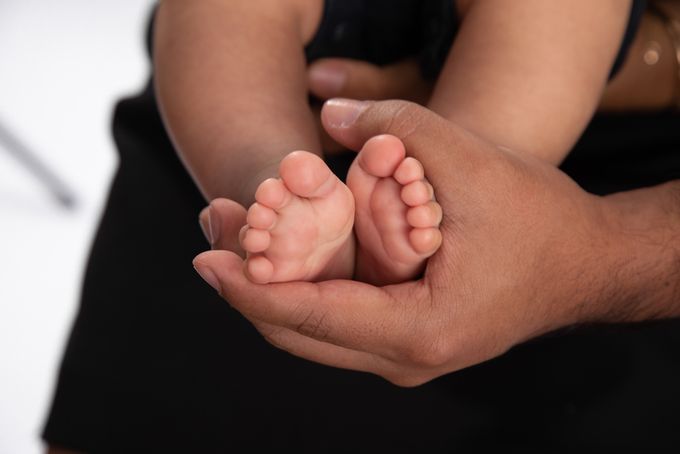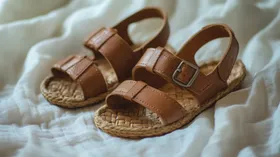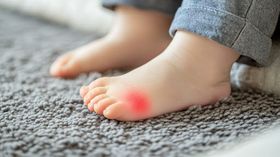Fat or Swollen Baby Feet? A Podiatrist-Backed Guide for Parents
Chubby feet = normal fat pads (esp. under the arch until ~2–3). Swelling = tight/red/warm skin and a press leaves a dent (pitting). See a doctor if it lasts >24h or comes with fever/discoloration/pain. For first steps, choose flexible, wide-toe shoes with a secure fit.
Updated September 26, 2025

Who can resist those adorable, puffy baby feet or the sight of your baby’s fat feet wiggling around? But have you ever wondered why they’re so soft?
Your baby’s feet are made mostly of fat, muscles, and tendons, which will eventually turn into bones. There’s also a natural layer of fat under the arch that makes them even softer.
But it's crucial to know the difference between 'fat' and 'swollen' feet. This guide, backed by podiatric principles, helps you tell the difference so you can ensure your little one’s feet are healthy.
Understanding Normal Development: Characteristics of Chubby Baby Feet
Normal, chubby baby feet are simply a part of healthy growth and development. They have several distinct characteristics:
Appearance: Puffy baby feet typically have a soft, rounded look with gentle contours.
Texture: The skin on chubby feet is generally smooth and relaxed, without signs of tension.
Mobility: Fat feet do not usually exhibit any signs of discomfort or restricted movement; your baby can wiggle their toes freely.
Developmental Context: The layer of fat under the arch is normal up to about age 2 or 3, giving the appearance of flat feet.
What Causes Swollen Baby Feet (Edema)?
Swollen feet in infants (edema) appear when fluid collects in the tissues [1,2]. While sometimes harmless, it's important to recognize the signs:
Appearance: Swollen feet may appear unnaturally puffy or enlarged compared to their usual size, and the skin may look stretched or tight.
Symptoms: Swelling can be accompanied by signs like redness, warmth, or tenderness in the affected area.
Common Causes: Swelling is often a result of wearing tight or ill-fitting footwear, minor bruises, insect bites, or staying in one position for too long (e.g., in a car seat).
Note: If you suspect your child has a condition like flat feet, read our guide on how to treat flat feet in children.
The Key Test: How to Tell if Your Baby’s Feet are Swollen (Pitting Edema Check)
If you’re unsure whether your baby has naturally chubby baby feet or swollen feet in toddlers, here is a simple, effective check:
Visual Inspection: Look closely for signs of puffiness, tension, or an unusual skin texture. Fat feet will appear rounded and soft without signs of tension in the skin.
The Touch (Pitting Edema) Test: Gently but firmly press on the top of the baby's foot with your finger for a few seconds [3]. If you remove your finger and it leaves a visible indentation that takes a few moments to disappear, this is a sign of pitting edema (swelling).
Movement Observation: Check if the baby can move their toes and feet comfortably. Swollen feet might restrict movement due to discomfort or pain.
Contextual Consideration: Think about recent factors. Has the baby been in a hot environment? Have they been wearing tight shoes or socks? These factors can help determine the likelihood of temporary swelling.
When to Consult Your Pediatrician or Podiatrist
While most minor swelling is temporary, you should consult a paediatrician or podiatrist if your baby’s feet look swollen and the swelling persists or worsens.
The swelling persists for more than 24 hours.
The swelling is accompanied by a fever, lethargy, or other signs of illness.
The area is visibly discolored (blue or purple) or extremely painful to the touch.
From Chubby to Confident: Choosing the Right First Walkers Shoes
It’s not just about fat feet in babies, but the right kind of podiatrist-designed support to protect against future issues like flat feet or swelling.
First Walkers' range of orthopedic shoes is your ideal choice. With their supple design, these shoes cradle your baby's feet in comfort. Our features, such as high ankle support, flexible soles, and wide toe boxes, are specifically engineered to promote natural foot movement and healthy development.
The easy-to-fasten straps ensure a snug, secure fit while the cozy sole pampers those tender feet. So, let your baby embrace their first steps, confident and carefree.
Help your kid's feet develop properly with our orthopaedic shoes.
Izvori:
- D. Lent-Schochet and I. Jialal, “Physiology, edema,” StatPearls - NCBI Bookshelf, May 01, 2023. Available: https://www.ncbi.nlm.nih.gov/books/NBK537065/
- A. Goyal, B. Singh, and M. Afzal, “Peripheral edema,” StatPearls - NCBI Bookshelf, Apr. 05, 2025. Available: https://www.ncbi.nlm.nih.gov/books/NBK554452/
- “Oedema Assessment,” Physiopedia. Available: https://www.physio-pedia.com/Oedema_Assessment
Disclaimer: First Walkers' information is intended for educational and informational purposes related to toddler footwear and feet. We encourage you to consider individual circumstances and consult qualified orthopaedists about specific conditions.
FAQs
Do swollen feet affect the baby?
Mild swelling in a baby’s feet usually doesn’t harm them. If swelling is severe, persistent, or accompanied by other symptoms, it may signal an underlying issue that needs medical attention.
How to reduce swelling in babies?
Gentle leg elevation, light massage, keeping the baby hydrated, and ensuring proper circulation with loose clothing can help. Always consult a pediatrician if swelling continues.
Can dehydration cause swollen feet?
Yes. Dehydration can lead the body to retain fluid, which may cause swelling in the feet or other areas.
What causes fluid retention in feet?
Common causes include dehydration, kidney or liver issues, heart conditions, infections, or poor circulation. In babies, it may also result from blocked lymphatic flow or underlying medical problems.
When does baby swelling go away?
Normal newborn swelling (often in the feet, hands, or eyelids) typically resolves within the first few days after birth. Persistent or worsening swelling should be evaluated by a doctor.
Related Articles

10 Best Winter Boots for Active Kids: Sturdy and Durable
Benjamin Aduwo
December 6, 2024

Practical and Pretty: 10 Regular-Cut Sandals for Little Girls
Babafemi Adebajo
December 6, 2024

7 Fun Activities for Kids and Parents Bonding
First Walkers
November 11, 2025

Online Shoe Shopping Guide for Kids: Finding the Perfect Fit
George Croft
June 13, 2024

Blisters on Infants' & Toddlers' Feet: Causes & Prevention
Jasrah Javed
January 9, 2025
Related Posts
Babafemi Adebajo
Do You Need a Prescription for Orthopaedic Shoes?
Babafemi Adebajo
Why Do My Toddler’s Feet Look Yellow?
Jasrah Javed
Do All Babies Initially Have Flat Feet?
Bhashwati Deb Barma
10 Best Shoes for Baby Foot Development: Support Happy Feet
Babafemi Adebajo
Toddler & Baby Sweaty Feet: Is It Hyperhidrosis?
Dr. Leah Alexander